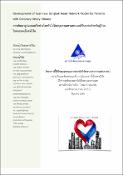บทคัดย่อ
โรคหลอดเลือดหัวใจ (Coronary artery disease; CAD) เป็นโรคไม่ติดต่อเรื้อรังที่สำคัญทางสาธารณสุขทั่วโลกรวมถึงประเทศไทย การเข้าถึงการสวนหัวใจและฉีดสีหลอดเลือดหัวใจ (Coronary angiography; CAG) และการขยายหลอดเลือดหัวใจด้วยบอลลูนและการใส่ขดลวดเคลือบยา (Percutaneous coronary intervention; PCI) เป็นการตรวจรักษาที่สำคัญสำหรับผู้ป่วยโรคหลอดเลือดหัวใจ โดยเฉพาะภาวะกล้ามเนื้อหัวใจขาดเลือดเฉียบพลัน (Acute coronary syndromes; ACS) ซึ่งมี 2 ประเภท คือ STEMI และ NSTE-ACS สำหรับผู้ป่วยโรคหลอดเลือดหัวใจตีบชนิดเรื้อรัง (CCS) ที่จะมาพบแพทย์ที่แผนกผู้ป่วยนอกพบว่ามีความล่าช้าในการเข้าถึงอายุรแพทย์โรคหัวใจ ทำให้ผู้ป่วยทั้ง 2 กลุ่ม ไม่สามารถเข้าถึงบริการสวนหัวใจและฉีดสีหลอดเลือดหัวใจภายในระยะเวลาที่เหมาะสม การศึกษานี้เป็นการศึกษาเชิงปฏิบัติการแบบมีส่วนร่วมจากสหสาชาวิชาชีพ ได้แก่ แพทย์ อายุรแพทย์โรคหัวใจ พยาบาลวิชาชีพ เจ้าหน้าที่ประจำห้องเวชระเบียนผู้ป่วยนอก คณะผู้บริหาร สำนักการแพทย์ กรุงเทพมหานคร โดยร่วมกันสำรวจปัญหา วางแผนความร่วมมือพัฒนาระบบ Seamless Bangkok Heart Network ซึ่งเป็นระบบการเชื่อมต่อและแลกเปลี่ยนข้อมูลทางคลินิก (Health Information Exchange; HIE) ผ่านระบบ cloud technology เพื่อ รับ-ตอบปรึกษาและส่งต่อผู้ป่วยโรคหลอดเลือดหัวใจ มีการเชื่อมต่อข้อมูลทางคลินิกที่ครบถ้วนและปลอดภัย โดยอาศัยการร่วมมือ (Collaboration) ระหว่างสถานพยาบาลแม่ข่าย คือ โรงพยาบาลตากสิน และสถานลูกข่าย ได้แก่ โรงพยาบาลหลวงพ่อทวีศักดิ์ ชุตินฺธโรอุทิศ โรงพยาบาลผู้สูงอายุบางขุนเทียน ศูนย์บริการการแพทย์ฉุกเฉินกรุงเทพมหานคร (ศูนย์เอราวัณ) โรงพยาบาลราชพิพัฒน์ และโรงพยาบาลกลาง โดยสถานพยาบาลลูกข่ายทั้ง 5 สถานพยาบาล จะส่งตัวผู้ป่วยโรคหลอดเลือดหัวใจมาที่โรงพยาบาลตากสิน โดยเปรียบเทียบอัตราการเข้าถึงการรักษาด้วยการ CAG/PCI ของผู้ป่วยโรคหลอดเลือดหัวใจที่ได้รับการส่งตัวผ่านระบบ Seamless Bangkok Heart Network กับการส่งตัวแบบเดิม (conventional referral) สำหรับสถานพยาบาลลูกข่ายจะได้รับการส่งตัวผ่านระบบการส่งตัวแบบใดขึ้นกับผลการสุ่มกลุ่มตัวอย่างแบบกลุ่ม (cluster randomization) ด้วยโปรแกรมทางสถิติ ผลการศึกษาพบว่าปัญหาที่เกี่ยวข้องกับการรับ-ตอบปรึกษาและส่งต่อผู้ป่วยโรคหลอดเลือดหัวใจสำหรับผู้ป่วย ACS คือ ข้อมูลทางคลินิกไม่ครบถ้วน เช่น ไม่มีผลเลือดเดิม ยาเดิมของผู้ป่วย ความไม่ปลอดภัยของข้อมูลทางคลินิกที่ถูกส่งผ่าน social media platform และจำนวนเตียงของโรงพยาบาลตากสินไม่เพียงพอ ปัญหาการส่งตัวผู้ป่วย CCS คือผู้ป่วยต้องเดินทางมาโรงพยาบาลตากสินหลายครั้งกว่าจะได้ทำการ CAG/PCI ทำให้ผู้ป่วยเสียเวลาเดินทางหลายครั้ง และใช้ระยะเวลานานกว่าจะเข้าถึงการรักษาด้วย CAG/PCI ได้ ผลลัพธ์ในการศึกษาตั้งแต่เดือนตุลาคม พ.ศ. 2567 ถึง มกราคม พ.ศ. 2568 มีจำนวนผู้ป่วยในการศึกษาทั้งหมดจำนวน 32 คน แบ่งเป็นส่งตัวผู้ป่วยหลอดเลือดหัวใจผ่านระบบ Seamless Bangkok Heart Network จำนวน 25 คน มีอายุเฉลี่ย 63.8 ปี เป็นเพศชายร้อยละ 60 และเป็นผู้ป่วย ACS ร้อยละ 60 สำหรับผู้ป่วยที่ส่งตัวผ่านระบบการส่งตัวแบบเดิม (conventional referral) จำนวน 7 คน มีอายุเฉลี่ย 64.1 ปี เป็นเพศชายร้อยละ 71.4 และเป็นผู้ป่วย ACS ร้อยละ 100 อัตราผู้ป่วยได้รับการรักษาด้วย CAG/PCI ภายในระยะเวลาเป้าหมายเปรียบเทียบระหว่างระบบ Seamless Bangkok Heart Network และระบบการส่งตัวแบบเดิม (conventional referral) ได้ผล ดังนี้ สำหรับผู้ป่วย ACS ชนิด STEMI พบว่า diagnosis to wire crossing ภายใน 120 นาที คือ ร้อยละ 66.6 และร้อยละ 40, p=0.46 ตามลำดับ สำหรับผู้ป่วย ACS ชนิด NSTMI ได้รับการ CAG/PCI ภายใน 72 ชั่วโมง คือ ร้อยละ 75 และร้อยละ 100, p=0.64 ตามลำดับ สำหรับผู้ป่วย CCS ได้รับการ CAG/PCI ภายใน 90 วัน ร้อยละ 90 สำหรับผู้ป่วยที่ส่งตัวผ่านระบบ Seamless Bangkok Heart Network แต่พบว่ามีการส่งตัวผู้ป่วยผ่านระบบ Seamless Bangkok Heart Network เท่านั้น ไม่มีผู้ป่วย CCS ส่งตัวผ่านระบบการส่งตัวแบบเดิม (conventional referral) สรุป การส่งตัวผู้ป่วยโรคหลอดเลือดหัวใจผ่านระบบ Seamless Bangkok Heart Network มีแนวโน้มช่วยให้ผู้ป่วยเข้าถึงการรักษาด้วยการ CAG/PCI ภายในระยะเวลาที่เหมาะสมมากยิ่งขึ้นเมื่อเทียบกับระบบการส่งตัวแบบเดิม โดยเฉพาะผู้ป่วย ACS ชนิด STEMI แต่จำนวนผู้ป่วยในการศึกษายังมีน้อยภายในระยะเวลาที่จำกัด ทำให้การประเมินผลทางสถิติมีข้อจำกัดและต้องการการศึกษาต่อเนื่องต่อไปเพื่อเพิ่มจำนวนผู้ป่วยให้เหมาะสม
บทคัดย่อ
Background: Coronary artery disease (CAD) is a major public health concern globally, including in
Thailand. Access to coronary angiography (CAG) and percutaneous coronary intervention (PCI) is
important for CAD patients, especially those with acute coronary syndromes (ACS). Delays in
accessing cardiology consultation and CAG/PCI have been observed for both ACS and chronic
coronary syndrome (CCS) patients.
Methods: This participatory action research involved a multidisciplinary team, including physicians,
cardiologists, nurses, medical records staff, and administrators from the Bangkok Metropolitan
Administration Medical Office. The team identified challenges and collaboratively developed the
"Seamless Bangkok Heart Network," a cloud-based health information exchange (HIE) system for
referral and consultation of CAD patients. The network connects Taksin Hospital (hub) with five
other hospitals (spokes) and the Bangkok emergency medical service center (Erawan center).
Patient data was securely exchanged, enabling timely referrals. The study compared conventional
referrals with referrals through the Seamless Bangkok Heart Network using cluster randomization,
assessing time-to-CAG/PCI for ACS and CCS patients.
Results: Key challenges identified included incomplete clinical information, data security concerns
with social media platforms, and limited bed capacity at the hub hospital. For CCS patients,
multiple visits to Taksin Hospital were often required before CAG/PCI, causing delays and
inconvenience. From October 2024 to January 2025, 32 patients were enrolled (25 in the Seamless
Bangkok Heart Network group, 7 in the conventional referral group). The mean age was 63.8±3.2
years and 64.1±4.1 years, respectively, with 60% and 71.4% males. ACS prevalence was 60% and
100%. For STEMI, diagnosis-to-wire crossing within 120 minutes was achieved in 66.6% and 40% of
cases, respectively (p=0.46). For NSTE-ACS, CAG/PCI within 72 hours was 75% and 100%,respectively
(p=0.64). For CCS, CAG/PCI within 90 days was 90% in the Seamless Bangkok Heart Network group;
no CCS patients were referred conventionally.
Conclusion: The Seamless Bangkok Heart Network showed a trend towards improved timely
access to CAG/PCI, particularly for STEMI patients. However, the limited sample size and study
duration restricted statistical analysis. Further research with a larger sample size is needed to
confirm these findings.


